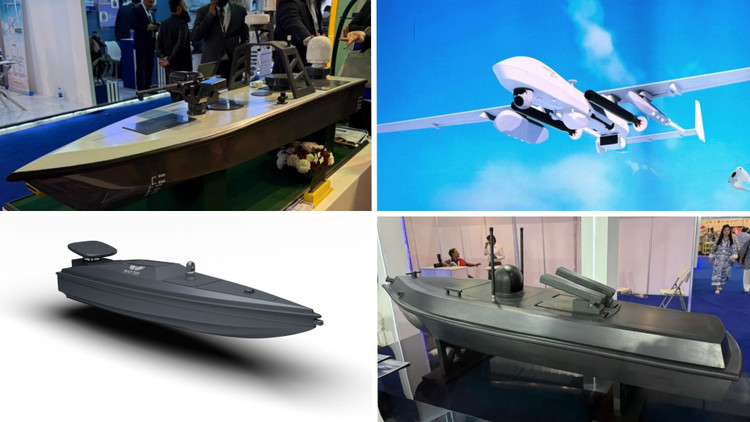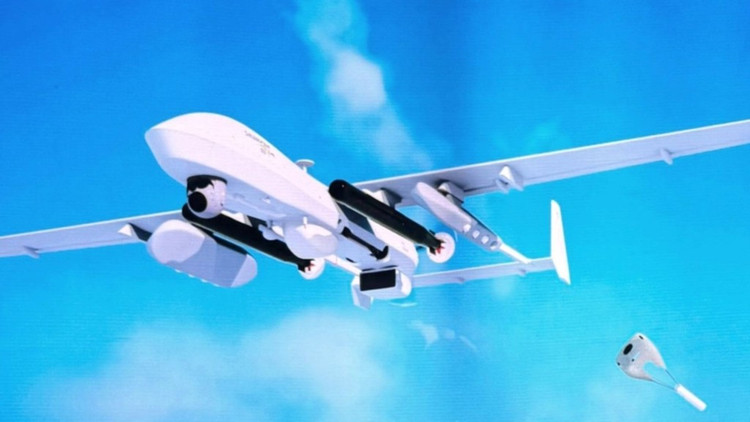At the Pakistan International Maritime Exhibition and Conference 2025 (PIMEC 2025), Pakistani defense industry companies showcased designs of unmanned aircraft systems (UAS), unmanned surface vehicles (USVs), and autonomous underwater vehicles (AUVs) they are developing.
Among them are the Stingray Technologies USV, the Beyond Koncept “Muhassir” USV, and the “Israr” AUV. Although marketed by private companies, each of these platforms appears to be being developed at one of the units under the National Science and Technology Commission (NESCOM).

Four brand new unmanned aerial vehicles (UAVs) were inducted by the Pakistan Navy.
NESCOM is a leading state-owned defense research, development and manufacturing entity with an ecosystem of subsidiaries specializing in various fields. Many NESCOM solutions can be found in the product portfolios of Stingray Technologies and Beyond Koncept, thus revealing their true nature as commercial subsidiaries of their respective NESCOM branches.
Global Industrial and Defence Solutions (GIDS), which normally acts as NESCOM’s sales and marketing arm, has also revealed a maritime variant of its upcoming Shahpar III unmanned aerial vehicle (UAS). Interestingly, concept videos of the maritime variant show a redesigned front fuselage along with a range of specialized equipment, including sonobuoys, Eghraaq lightweight torpedoes, synthetic aperture radar (SAR), and an electronic and communications intelligence (ELINT/COMINT) suite.
Overall, the fact that as many as four different unmanned platforms are being developed specifically for maritime purposes – i.e. three combat-capable USVs, at least one unmanned underwater vehicle (UUV)/AUV, and a medium-altitude, long-endurance (MALE) UAS – suggests that the Pakistan Navy (PN) is placing more emphasis on unmanned systems in its long-term acquisition roadmap.
In July, the PN leadership announced it would pursue unmanned systems for surface, underwater, and air needs – each of these concepts is evidence that the Navy (NHQ) is serious about this.
Quad of strategic unmanned vehicles
The first vehicle mentioned is the Muhassir Unmanned Semi-Submersible Vehicle, which has an overall length of 10 meters and a displacement of 7.3 tons. It is capable of reaching speeds of up to 40 knots and a cruising speed of 30 knots using its waterjet propulsion system. The Muhassir has a published continuous range of over 400 nautical miles.

USV Muhassir has a length of up to 10 m and a displacement of 7.3 tons.
Overall, the Muhassir is considered a good intelligence, surveillance and reconnaissance (ISR) platform, and is equipped with basic weapons (i.e., a 12.7mm autocannon via a remote weapon station or RWS). However, its configuration – i.e., guidance/search radar, electro-optical (EO) turret, LiDAR, panoramic cameras, GNSS, INS and Automatic Identification System (AIS) – is more focused on providing situational awareness.
In fact, the selection and configuration of this subsystem shows that PN has issued a comprehensive set of requirements, emphasizing the construction of an effective sensing, navigation, and networking system. The inclusion of a SATCOM terminal, dedicated RF antenna, and optoelectronics equipment shows that PN wants to build long-endurance, networked operations through USVs rather than a minimally operated vessel.
With a range of over 400 nautical miles, the Muhassir can be designed to operate beyond Pakistani ports. If deployed from Pakistan Navy (PN) bases in Karachi, Ormara or Gwadar, it can patrol most of Pakistan’s coastal areas, station at major entrances to these ports, and even operate along Pakistan’s major sea lanes to conduct continuous ISR operations.
However, the advertised “explosive hatch” is clearly a notable design choice as it hints at the USV’s potential one-way strike role, otherwise reusable. This could be an indication that a future version of the Muhassir will be designed as a kamikaze USV with a warhead that would allow the PN to have a MAGURA-style strike capability without the need for design modifications.

Another mysterious USV developed by NESCOM was displayed but no specific specifications were given.
Interestingly, another NESCOM unit also showed off its own USV, but did not reveal most of its specifications. This USV has an overall length of 7.62 meters and can operate continuously for four to five hours, and is equipped with guided weapons (possibly four surface-to-surface missiles/rockets).
Due to the lack of specific details, it is difficult to compare this USV to the Muhassir, but the model shows that the designers took a much simpler, less ostentatious approach. The armament suggests that this USV was designed with offensive purposes in mind from the start. Furthermore, the very low sides and dark, smooth deck suggest that the intention was to minimize visibility, especially at night.
In fact, the upper part of the ship is minimally equipped, with only an EO turret, a few small pods that could be antennas, and two rectangular bays for electronic or nuclear warheads. But unlike the Muhassir, this USV has no tall mast, radar canopy, RWS, or SATCOM. The slogan “Unmanned. Undetectable. Unstoppable” also emphasizes the idea of stealth and speed over versatility.
This design may therefore be the first clear indication that Pakistan is developing a Magura-type littoral attack craft. The craft would be able to operate on pre-planned routes (using GNSS/INS), and when in the terminal phase or attack zone, a switch (via radio direct line of sight control) would be deployed to manual control. Therefore, in addition to missiles, the USV may also have an explosives hatch to allow weapons to be carried for kamikaze missions. This USV – with its lighter subsystem load, stealthier profile, and shorter endurance – appears to be more vulnerable than resilient in nature.

The Corsair suicide USV was developed by the private company Woot-Tech.
Pakistan's private sector is also getting involved in the USV space. Woot-Tech's Corsair is being marketed as a kamikaze platform, designed to attack "armored warships and port facilities without being easily detected or intercepted."
According to Woot-Tech, the Corsair can reach speeds of 30 knots, carry a payload of 50 kg, and has a range of about 100 nautical miles. It has an overall length of 4 m and a flight time of three hours.
Given the advertised role, it is reasonable to assume that the Corsair's subsystem prioritizes navigation and control over extensive sensor use. The most likely configuration would involve GNSS/INS-based navigation, combined with a small EO turret for terminal guidance under operator control.
The description of the Corsair as being difficult to detect and intercept also alludes to a low hull with minimal masts or superstructure (this can also be seen in the design concept), trading off persistent ISR capabilities and long-range connectivity for reduced radar and visual signature.
In fact, the Corsair is closer to a “pure” kamikaze (like the Magura) than a multi-mission USV like the Muhassir. In this sense, the Stingray Technologies USV can be an “either/or” role, as it can be configured for a variety of roles, but is more focused on weapons deployment than serving a single purpose.
In fact, the Corsair could promise lower procurement costs and thus the ability to scale to larger numbers (e.g., for swarming assault missions and the possibility of being destroyed by suicide missions).

The Shahpar-3 drone can carry lightweight torpedoes.
The Shahpar-3 maritime configuration, showcased at PIMEC 2025, is a navalized or overall improved variant of the drone. The concept of the aircraft being equipped with lightweight torpedoes, sonobuoys, and specialized sensors was revealed at the International Defence Exhibition and Conference 2024 (IDEAS 2024).
Instead, the change is really an attempt to present a built-in maritime solution. The naval variant appears to have an improved or modified forward hull – whether this is a general improvement or a tailor-made measure to prevent salt erosion remains unclear. Interestingly, the design has yet to be demonstrated in its intended anti-ship warfare (AShW) capability via the Rasoob 250 air-launched cruise missile (ALCM).
Overall, the Shahpar-3 is likely to be positioned as a long-endurance maritime patrol and anti-submarine warfare (ASW) platform. The Philippine Navy may be interested in using it as a complement to its upcoming Sea Sultan long-range maritime patrol aircraft (LRMPA), allowing it to extend and enhance its operational range without relying entirely on high-value manned aircraft.
Source: https://khoahocdoisong.vn/pakistan-trinh-lang-loat-tau-tan-cong-khong-nguoi-lai-post2149069515.html








































































































Comment (0)